Wexford’s Comoradh ’98
Published in 18th–19th - Century History, Features, Issue 2 (Summer 1998), The United Irishmen, Volume 6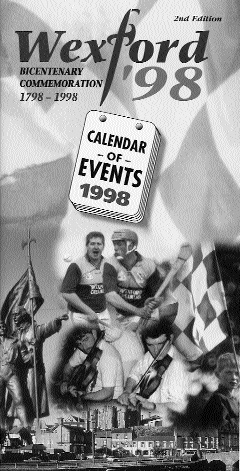
Launching the Irish government’s 1798 commemorations earlier this year, the Taoiseach, Mr Ahern, declared: ‘we are commemorating the most sustained effort in Irish history to reconcile and unite what were the three communities with different religious beliefs and ethnic backgrounds—Protestants, Catholics and Dissenters’. He spoke on behalf of ‘a sovereign Irish government’, that, he claimed, ‘can trace its political lineage back to 1798 when the first republics in Wexford and Connaught were declared’.
An official history?
Given that history is a matter of interpretation rather than some agreed objective reality, how did the State come up with the version of 1798 articulated by the Taoiseach? What, especially, is the basis for his belief that it was primarily a United Irish enterprise, involving the declaration of local republics, from which the present Irish Republic can trace descent?
One likely source is the literature of Comoradh ‘98, the Wexford 1798 commemoration committee. Established by the County Council, it has had significant input from enthusiastic local historians, and attracted government backing. Its logo encapsulates what is now the state version: ‘the United Irish Revolution of 1798’. Its literature not only claims that this revolution ‘led to the nation’s first republic’, but that it was declared by a ‘senate’, whose eight-man ‘council’ comprised an equal number of Catholics and Protestants. Yet there is little or no evidence for any of these so-called features of 1798 in Wexford; little for ‘the United Irish Revolution’, and none at all for ‘the Wexford Republic’ or the Wexford ‘Senate’. What then is their source, and why are they now commonplaces, seemingly needing no defence or justification?
The Cullen thesis and its distortion
In an article in Wexford: history and society (1987) Louis Cullen challenged the long-accepted view (first articulated by the United Irishmen themselves) that there was no significant United Irish organisation in Wexford prior to the outbreak. Cullen had no new documentary evidence (nor has any come to light since) but instead he brilliantly deconstructed the main contemporary accounts, which sought to distance the United Irish from a bloody, chaotic and often sectarian conflict, so different from their projected heroic war of national liberation, and he showed how they almost certainly concealed a very different reality. In addition he used a list originally printed by the loyalist historian Sir Richard Musgrave (1801) together with scattered references to the military ranks of rebel leaders, and his extensive knowledge of kinship groups and radical politics, to project an organisation of six or seven ‘regiments’ of United Irishmen and to link their distribution to the outbreak and early course of the rebellion.
It was a tour-de-force which offered a new understanding of hitherto puzzling aspects of 1798 in Wexford, but it was also scrupulously presented as a hypothesis, and its limited basis in contemporary documents was fully acknowledged. Within two years, however, a version of it had been literally carved in stone, on a monument placed on Vinegar Hill by Cumann Comórtha 1798. Its lengthy ‘revisionist’ text stresses the role of the United Irishmen, and claims further that ‘the ‘98 insurrection established a revolutionary spirit and [that] the republican ideology of Tone and the United Irishmen inspired a new form of patriotism. This ultimately led to a democratic system of government in Ireland’. Now, for the bicentenary, Cullen’s sophisticated hypothesis has been reduced to the crude slogan, ‘The United Irish Revolution’. Leaving aside the improper use of ‘revolution’ (with its implied achievement of fundamental political and social change), the emphatic and sole use of ‘United Irish’ to categorise the rebellion goes far beyond any reasonable interpretation of the evidence, and does little to explain the reality. It reflects an old-fashioned mono-causal nationalist perspective and ignores the complex of economic, social and cultural factors revealed by the work of Tom Powell, Kevin Whelan, Daniel Gahan, and above all Louis Cullen himself, in recent decades. It allows no role, for example, to the intense sectarian/agrarian conflicts at a variety of social levels that were such a feature of the county in the decades leading up to ‘98, and which had already led to a major conflict with the forces of the state in 1793, still remembered as ‘the first rebellion’.
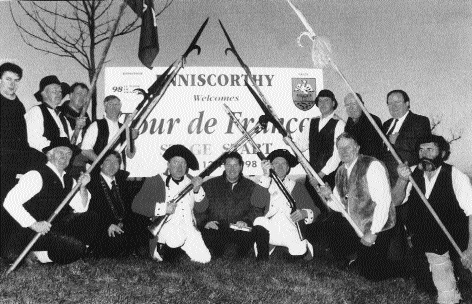
The French to arrive at last? Stephen Roche (centre), promoting the Wexford stage of the 1998 Tour de France, surrounded by members of Comí³radh ‘98 and Wexford pikemen. (The Echo and South Leinster Advertiser)
Of course the United Irish contribution should be fully taken into account (insofar as the evidence allows), but it is best seen as a very recent layer of politicisation on top of older patterns, which had their origins in a still recent experience of colonisation. Indeed, on the Wicklow border, where we have the clearest evidence for United Irish recruitment, we also know that it succeeded partly because it exploited sectarian conflict. Only a proper assessment of the lethal mix of old and new ideologies, of local rivalries, of rumour and fear, and of out-of-control state repression can explain the horrific death toll and the long catalogue of atrocity that formed the predominant reality of 1798 in Wexford.
Daniel Gahan’s recent account of the Wexford rebellion has the more appropriate title, The People’s Rising, and is circumspect about the role of the United Irishmen, acknowledging ‘the fragments of evidence we have’. He denies emphatically that the rebel leaders declared a Wexford ‘republic’, and there is not a scrap of evidence to support the more extreme claims made for this imaginary body, such as that it ‘administered the county during the rebel occupation’ and ‘fought twenty one battles, but fell on Vinegar Hill’. The fascinating documents we have from the ‘council’ in Wexford town, which protected property and regulated the food supply during the rebel occupation (and was the nearest the rebellion got to an experiment in government) certainly reveal French influences, and claimed to act for ‘the people’, but they never mention the ‘Republic’. This term was used initially, and pejoratively (and without a capital R) by Musgrave. Similarly the only clear contemporary reference to a ‘senate’ is by George Taylor, a former prisoner of the rebels, who shared Musgrave’s perspectives. He uses it to demonstrate the godless revolutionary face of the rebellion, which he claims is simply a mask for the persecution of Protestants. It is ironic that ultra-loyalist smears should form the basis of a modern ultra-nationalist interpretation.
The business of ‘heritage’
While it promotes a highly political historical thesis, Comoradh ‘98 has always had other and more prosaic concerns, especially the promotion of tourism. This reinforces the significant but unacknowledged shift, already evident in the work of some enthusiastic local historians, from ‘comoradh’ to ‘ceiliuradh’—from commemoration to celebration. This shift is facilitated by the focus on the idealism of the United Irishmen, and by averting the gaze from the more unfortunate aspects of the rebellion. As we have learned in recent years, the ‘celebration’ of mass destruction is a tricky business (though some elements of the Famine commemoration came close to attempting it). Louis Cullen has remarked (Irish Times, 28/1/97) that ‘commemoration is a strange communal, tribal activity, rather like an All-Ireland or a rugby international’.
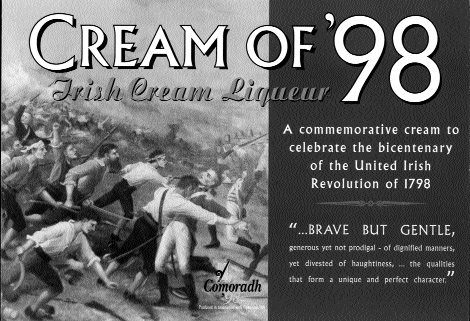
And so it is no surprise to find that the cover of the glossy brochure, Wexford ‘98: Calendar of events, issued by Comóradh ‘98, features modern hurling heroes (with Fr Murphy and the pikeman relegated to a supporting role) and is tastefully produced in the purple and gold colours of the county GAA teams. Inside the cover the County Manager extends ‘fáilte to all visitors to the county’, and the hon. secretary of Comoradh ‘98 urges, ‘come and join us for this great year’. This was an emphasis of his committee from the beginning, its first newsletter giving, among ‘ten good reasons for commemorating 1798’, ‘that it will benefit our county touristwise’. The third newsletter is ecstatic that the 1998 Tour de France will start in Ireland, and include Enniscorthy as ‘a stage to commemorate the 1798 rebellion’. And so, the French will arrive at last, two hundred years late, and with an army of ‘over one thousand media’, rather than the one hoped for in 1798.
The rebellion is, in effect, being commodified and packaged for the usual queasy combination of commercial and educational motives that characterises the ‘heritage’ industry. Various ‘heritage’ and ‘visitor’ centres, a ‘heritage’ trail, the sale of ‘98 memorabilia, events like ‘’98: the show’—all raise concerns about the manipulation and distortion of our understanding of the past. The brochure for the ‘National 1798 Visitor Centre’ in Enniscorthy reassures us that its ‘dramatic interactive multi-media experience’ will also ‘help make the visitor aware that the view being presented is itself an interpretation’. However, its outline of ‘the story of the 1798 rebellion’ would seem to meet the expectation of local historian, Nicholas Furlong, that the centre would ‘remove unnecessary baggage like sectarian division’. Strong on ‘the age of Enlightenment’ (which the visitor will enter across ‘the bridge of democracy’), its account of ‘the United Irishmen’s Wexford rebellion’ will clearly be as bland as any nervous parent, or local politician or businessman could wish. One can only hope that exposure to the actual evidence of a rather messier reality will make it unlikely that the many local history projects arising from the bicentenary will be shaped by this reduction of the rebellion to ‘heritage’, a pre-packaged, simplistic and politically correct version for mass-consumption. A particular form of consumption, long associated with critical phases of the rebellion is featured in a commercial enterprise endorsed by ‘Comoradh ‘98’. Whatever the truth of the claim, ‘it was drink that brought us down’, the recently launched ‘Cream of ‘98: Irish cream liqueur’ will doubtless have a more uplifting effect!
The memory of the dead
Growing up in New Ross, my early life was saturated in the culture of ‘98, its ballads and folklore, its monuments and heroes. This has heightened my awareness that the events we commemorate this year were so terrible and traumatic that we have never confronted them. The temptation has always been there—and has usually been given into—to make a horrific past palatable, and this has not only robbed people of their history, but has made it more difficult for us as a community to face the still lethal legacies of that time in our own day. Any commemoration of 1798 in Wexford should keep in full view the overwhelming fact that perhaps in excess of twenty thousand people died horrible deaths in the course of three hot summer weeks in that prosperous county. The vast majority of them were ordinary people either rebels or innocent bystanders, killed in their own fields and homes. They died for the most part unrecorded, either in the formal ‘battles’ whose names resonate through the ballads, or in the myriad of small and large-scale atrocities both by state forces, out of control or used as instruments of sectarian retribution, and by the rebels for reasons that were often personal as well as ideological.
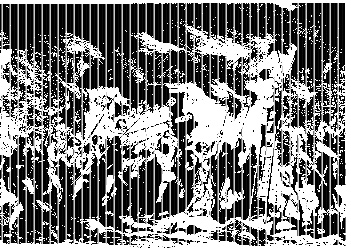
My own small research project concerns the battle of New Ross on 5 June 1798, the most bloody and decisive of the rebellion. Nearby, on that same day, occurred the most notorious rebel atrocity, the burning of over a hundred men, women and children, almost all Protestant, in the barn at Scullabogue, a half mile from where I was born, but which I never heard of as a child. In the aftermath of the battle my maternal great-great-great grandfather, John Rice of the Irishtown, a prominent Catholic businessman, was killed by the army; a family story has it that he was sheltering women and children in a loft. He was just one of perhaps 3,000 people killed in that sleepy little town on that day, and like many of them appears to have been an innocent bystander. It is impossible to read the contemporary accounts of that battle, or of Scullabogue—or indeed of the outbreak in Wexford generally—and not be endlessly reminded that this was an event soaked in blood, and marked more by cruelty and fanaticism on both sides than by the ideals of the Enlightenment. And so I am obliged to disagree profoundly with Kevin Whelan’s view that, ‘we must relinquish our obsession…with pikes and deaths, murder, mayhem and martyrdom. We should stress instead the living principles of democracy and pluralism which the United Irishmen formulated’ (in The Mighty Wave). This seems bad politics as well as dubious history. However universalist in origin, the principles of the United Irishmen have long ago become identified with one side in the Northern Ireland conflict, and no ‘peace process’ can succeed through the rehabilitation of their rhetoric, or by constitutional arrangements alone. As the United Irishmen found, obstinate realities like sectarian conflict are not so easily overcome. Many of the killings on both sides in 1798, as in Northern Ireland today, involved victims and their killers, not only from opposite sides of the sectarian divide, but who also knew one another.
In celebrating the idealism of the United Irishmen in the simplistic manner of the official commemoration, there is the risk of seeming to say that such idealism justified the precipitation of wholesale and predictable slaughter. During the recent Famine commemoration, ‘revisionist’ historians were berated for paying insufficient attention to the trauma of its million victims. If we are now being called on to ignore the 30,000 dead of the 1798 rebellion, it may be hard to resist the conclusion that those dead are politically inconvenient because they raise the question of the responsibility of Irish republicans, while those of the Famine brought the failure of the British government into focus. I am more in agreement with Kevin Whelan’s recent comment, ‘As Nietzche said, “history is what hurts”, and sometimes things hurt so much that they can’t have articulation. It takes a long, long time for them to work through…You can’t restore the past, but you can restore memory and that’s what the whole process of commemoration is about’ (Irish Times, 21/1/98). Would that it were so in this case. Much evidence survives for the buried or unacknowledged memory of 1798 in Wexford, and it does not reveal that this featured a glorious United Irish contribution, later suppressed by a remarkable conspiracy, involving first ultra-Protestants and then ultra-Catholics. In the case of Catholics, who are often, like my ancestor, not to be found in the official record, this evidence can be found in folklore and contemporary ballads in both English and Irish; in the case of Protestants, there is greater ease of access through contemporary accounts, diaries, letters and depositions. The overwhelming evidence on both sides is of chaos, arbitrary death and sectarian-inspired atrocity. A commemoration that does not confront such realities is not worthy of the name. The impatience of some at any mention of Scullabogue is interesting. Of course it does not define the whole rebellion (any more than the United Irish element does), but a real attempt must be made to understand it and to put it in context. Comoradh ‘98 seem to be in denial about it. Their sole concern, to establish that the United Irish leadership condemned the atrocity, is not unlike the claim in the local folklore that it was not done by natives of the parish.
Letting the subaltern speak
Strikingly absent from the plethora of new studies of 1798 is any reassessment of the motivation or mentalité of the rank-and-file Wexford rebels. Kevin Whelan has argued (in The Tree of Liberty) that United Irish politicisation prior to the outbreak created what he called ‘the republic in the village’, but he didn’t carry forward the analysis into the rebellion itself. This was not surprising, given the paucity of sources on the rebel side, as Thomas Pakenham pointed out thirty years ago. Those who attacked New Ross on 5 June, for example, and showed such heroic determination and reckless courage, were mainly countrymen, from my father’s home area, south of Enniscorthy, a major area of sectarian/agrarian conflict during earlier decades. The view we get of them in the official record, like court-martials, is of course biased, but also complex, and their appearance in ‘loyalist’ accounts likewise features humanity as well as savagery. As studies of popular insurgency elsewhere have shown, such sources can reveal much more than appears at present, and there are others that have been utilised even less, notably contemporary popular ballads or songs in both English and Irish, and folklore, much of it collected within fifty years of 1798. An important new dimension opened up for me as the evidence accumulated that ‘the Bantry men’ who attacked New Ross were strongly Irish-speaking. As both Whelan and Jim Smyth have pointed out, this would help to account for the lack of clear evidence for United Irish penetration of their traditional culture. The only contemporary poem about the battle that survives is in Irish, ‘Bualadh Ros Mhic Thriúin’ (the defeat of New Ross) which combines reference to the revolutionary wars raging in Europe with the traditional categorisation of the enemy of the rebels as ‘clanna Luther’ (Luther’s breed).
The scarcity of Gaelic materials for the Wexford rebellion makes the series of poems by the Cork poet and United Irish sympathiser, Micheál Óg Ó Longáin, especially significant. He was at the centre of a network of Gaelic intellectuals (including some Wexford connections) combining a keen interest in European affairs with plans to revive the fortunes of the Irish language. In literary terms, Ó Longáin was firmly in the old aristocratic Jacobite tradition. His half-dozen 1798 poems, all contextualised and some commented on by himself, show the same potentially ‘revolutionary dynamic’ that Tom Bartlett discerned in Defender texts, which mixed traditional grievances and expectations with those of contemporary revolution. His contextual notes, and to a lesser degree his poems, contain echoes of United Irish ideology, otherwise virtually unknown in contemporary Gaelic literature. Yet the poems remain firmly in the seventeenth-century tradition represented by Ó Bruadair, being vehemently anti-settler, anti-Protestant, and focused on the recovery of lost lands and the restoration of the old families and the old religion.
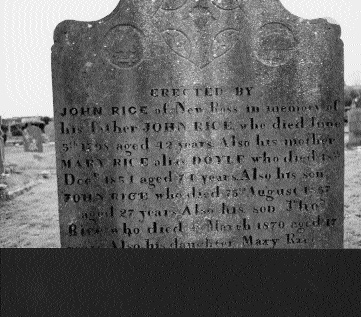
Gravestone of John Rice, Irishtown, New Ross-maternal great-great-great grandfather of the author
In the best known of them, ‘Beir litir uaim don Mhumhain’ (Bring a letter from us to Munster), the basis of the traditional song, ‘Maidean Luain Chinchise’, the Wexford rebels appeal to their Munster supporters to join them and they categorise their rebellion in terms of ‘Gallabhúir de dhíbirt/As fearann dúchais, díleas/Ár sinsear go deo’ (to drive out the foreign boors from our ancestral lands forever). Similar Jacobite sentiments were articulated in politically radical ‘amhráin na ndaoine’ (songs of the people) between the 1780s and the Famine; thus an old and seemingly outmoded elite discourse became, improbably, a major vehicle for popular disaffection.
The context of colonisation is critical to any understanding of 1798 in Wexford, where there were significant new Protestant settlements well into the eighteenth century. Some of these families were particularly targeted by the rebels, including at Scullabogue. Thomas Cloney, one of the rebel leaders in the attack on Ross, expressed his hatred of the ‘knot of descendants of Cromwellian settlers’, and this formula recurs in ballads and folklore. New Ross had a centuries old history as a walled colonial enclave under siege. The rebels in 1798 were following the example of Art Mac Murrough’s army in 1394, and even broke into the town by the same gate. More than Musgrave connected the rebellion to earlier colonial conflicts. This was also done, with surprising sympathy, in the novel, The Milesian Chief (1812) by the Church of Ireland cleric, Robert Maturin and in Gaelic prose. Our best hope of understanding the Wexford rebels may be to adopt the approach of the collective project of Indian Marxist historians, known as ‘subaltern studies’. As the key to rewriting modern Indian history ‘from the perspective of the continuous chain of peasant insurgencies during the colonial occupation’ (Spivak), it seeks to let the subaltern speak, that is to recover the hidden history of the rural poor from the dominant historical narratives—and ideologies—of the elites. In the Irish case these include the United Irishmen, as much as the Ascendancy or the Catholic Church. Until we establish a better understanding of traditional popular culture, especially through an analysis of Gaelic language and folk material, we cannot assess properly the impact on it of the very recent dissemination of the ideas of contemporary European revolution.
Tom Dunne lectures in history at NUI, Cork.
Further reading:
D. Gahan, The People’s Rising: Wexford 1798. (Dublin 1995)
K. Whelan, The Tree of Liberty.(Cork 1996)
R. Ó Donnchadha (ed.), Micheál Óg Ó Longáin: dánta.
R. Guha et al. (eds.), Subaltern Studies (1982, continuing).
















